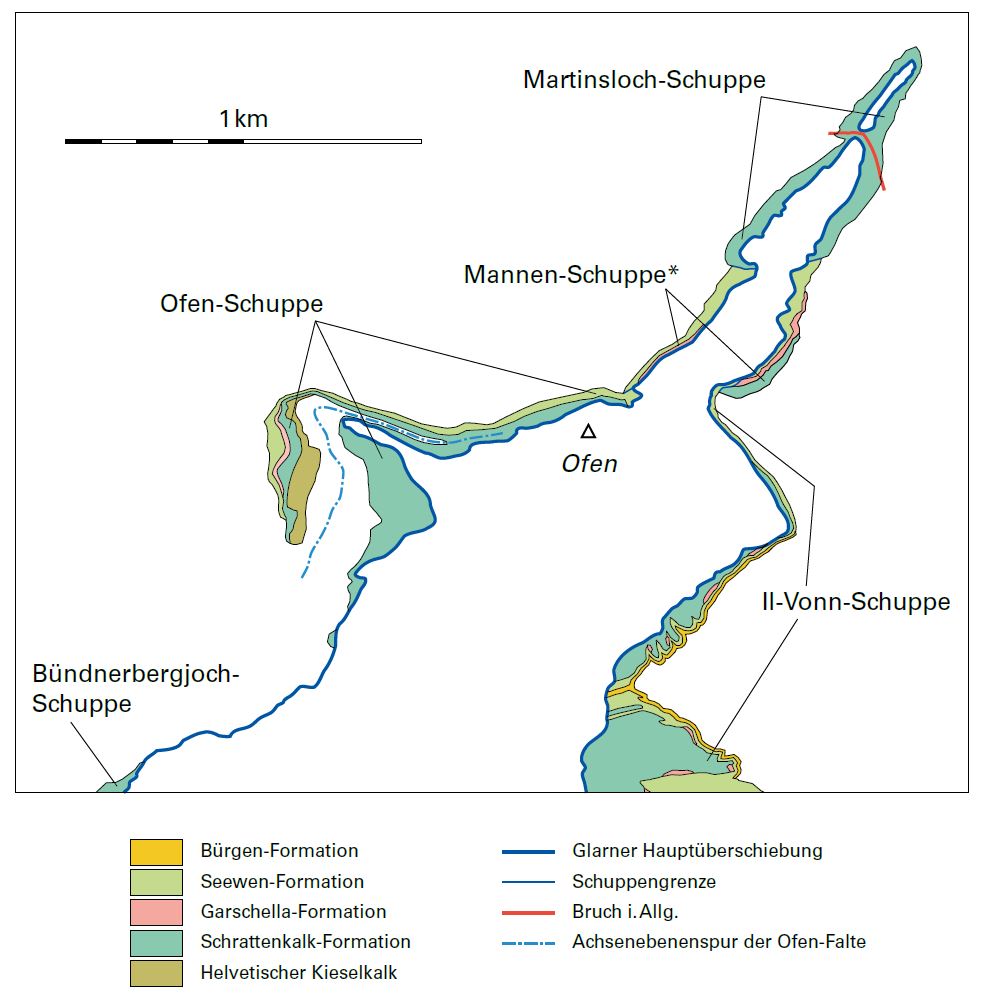Tschingelhörner-Schuppen
Representation and status
- Color CMYK
- (0%,0%,0%,100%)
- Color RGB
- R: 241 G: 239 B: 237
- Rank
- tectonic slice
- Validity
- Unit is in Use
- Status
- informal term
Nomenclature
- Deutsch
- Tschingelhörner-Schuppen
- Français
- Écailles des Tschingelhörner
- Italiano
- Scaglie dei Tschingelhörner
- English
- Tschingelhörner Slices
- Origin of the Name
- Historical Variants
-
subhelvetische Schuppen = Scherben (Trümpy 1969, Schmid 1975), allochthone Schuppen des Infrahelvetikums (Milnes & Pfiffner 1977, Lihou 1996), Tschingelhörner-Schuppen (den Brok et al. 2021), Tschingelhörner Slices (Gouffon et al. 2024)
Description
- Description
-
Allochthone Teile der Sedimentbedeckung des Aar-Massivs, die als Relikte frontaler Partien der helvetischen Decken des Hangenden in späteren Phasen der Überschiebung unter die Hauptüberschiebung gerieten und überfahren wurden.
Hierarchy and sequence
- Units at roof
- Units at floor
Geography
- Geographical extent
- Ofen, Atlas, ...
Palaenography and tectonic
- Tectonic unit (resp. main category)
- Kind of protolith
-
- tectonic
References
- Definition
-
(2021) :
Blatt 1174 Elm. Geol. Atlas Schweiz 1: 25 000, Erläut. 173
S.18: Tschingelhörner-Schuppen (7): Auf dem Schabell-Melange liegen an verschiedenen Orten die Tschingelhörner-Schuppen. Dies sind allochthone Teile der Sedimentbedeckung des Aar-Massivs (Frühe Kreide – Eozän), die als Relikte frontaler Partien der helvetischen Decken des Hangenden in späteren Phasen der Überschiebung unter die Hauptüberschiebung gerieten und überfahren wurden.
- Definition
-
(2024) :
Tectonic Map of Switzerland 1:500000, Explanatory notes. Federal Office of Topography swisstopo, Wabern
p.37: The Tschingelhörner Slices occur on top of the Schabell Mélange and consist mainly of Cretaceous limestones. They are characteristic of the footwall of the Glarus Thrust. These slices were torn off their substratum during the thrusting of the Glarus Nappe Complex. They are too thin to be depicted individually on the map and consequently have been grouped with the Schabell Mélange. Further north, under the Glarus Nappe Complex, thin slices of similar but more deformed limestones occupy the same structural position; they are known as the “Lochsiten- Kalk”.
-
Martinsloch-Schuppe
- Rank
- tectonic slice
- Status
- local name (informal)
-
Mannen-Schuppe
- Rank
- tectonic slice
- Status
- local name (informal)
-
Ofen-Schuppe
- Rank
- tectonic slice
- Status
- local name (informal)
-
Il-Vonn-Schuppe
- Rank
- tectonic slice
- Status
- local name (informal)
-
Buendnerbergjoch-Schuppe
- Name Origin
-
Buendnerbergjoch (GR)/(GL)
- Rank
- tectonic slice
- Status
- local name (informal)
-
Atlas-Schuppen
- Rank
- tectonic slice
- Status
- local name (informal)
-
Fil-de-Cassons-Schuppe
- Rank
- tectonic slice
- Status
- local name (informal)
-
Foostock-Schuppe
- Rank
- tectonic slice
- Status
- local name (informal)
-
Unterer Lochsiten-Kalk
- Rank
- tectonically bounded lithostratigraphic unit
- Status
- local name (informal)
- In short
-
Unterer Teil des Lochsiten-Kalkes, der als kuspat-lobate Falten erscheint.

